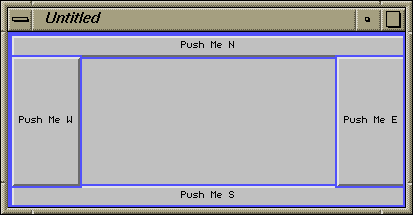

- #Set the layout manager to use the default flowlayout how to#
- #Set the layout manager to use the default flowlayout code#
JFrame frame = new JFrame("Flow Layout") However, I wont deal with this option here.) As for adding components to a container, thats easy. This allows you to take complete charge of laying out the components in the container. (It is possible to set the LayoutManager of a container to be null.

To use it you will need to set JFrame layout by using tLayout(layout) and to pass flow layout as a parameter.įollowing example shows components arranged in flow layout: package You can change the layout manager of a container using its setLayout (LayoutManager) method. Align property determines alignment of the components as left, right, center etc. For example from left to right or from right to left:įlow layout arranges components in line and if no space left all remaining components goes to next line. If no call to setLayout( ) is formed, then the default layout manager is employed. It consists of five fixed areas: North, South, East, West, and Center. The layout manager is about by the setLayout( ) method. It is used to arrange components in a line or a row. The border layout is the default layout manager for all Window objects. The FlowLayout class provides a very simple layout manager that is. setting flow layout of right alignmentį.setLayout(new FlowLayout(FlowLayout.You can also use something like Flow Layout which is the default layout used by JPanel. If you are interested in using JavaFX to create your GUI, see Working With Layouts in JavaFX. It is the default layout of the applet or panel.įlowLayout(): creates a flow layout with centered alignment and a default 5 unit horizontal and vertical gap.įlowLayout(int align): creates a flow layout with the given alignment and a default 5 unit horizontal and vertical gap.įlowLayout(int align, int hgap, int vgap): creates a flow layout with the given alignment and the given horizontal and vertical gap.Įxample of FlowLayout class: Using FlowLayout(int align) constructorį.add(b1) f.add(b2) f.add(b3) f.add(b4) f.add(b5) The Java FlowLayout class is used to arrange the components in a line, one after another (in a flow). If you set the layout manager of a container to be null, by calling container. Set Layout (new FlowLayout (FlowLayout.LEFT)) ī2=new Button("Button 2") b3=new Button("Button 3") For out next example, well look at a panel that does not use a layout manager. Places components sequentially (left to right) in the order they were added.

Public class FlowLayout Demo extends Frame When no more components fit on a line, the next one appears on the next line.įlowLayout() // creates a flow layout with centered alignment and a default 5 unit horizontal and vertical gap.įlowLayout(int alignment) //creates a flow layout with the given alignment and a default 5 unit horizontal and vertical gap.įlowLayout(int alignment, int horz_gap, int vert_gap) // creates a flow layout with the given alignment and the given horizontal and vertical gap.

There are the following classes that represent the layout managers:. LayoutManager is an interface that is implemented by all the classes of layout managers. Here the buttons are arranged in a single row, centred at the top of the window. Components are laid out from the upper left corner, left to right, and top to bottom. The Java LayoutManagers facilitates us to control the positioning and size of the components in GUI forms. A FlowLayout manager uses this information to size and position the buttons. It simply arranges components in a single row, starting a new row if its container is not sufficiently wide. (If the direction chosen is left, other choices are available.) It is similar to the null layout. The proper layout should be chosen to accommodate frame resizings and use. Layout Managers are used in the organization of Panels and Frames. Flow layout puts components (such as text fields, buttons, labels etc) in a row, if horizontal space is not enough to hold all components then Flow layout adds them in a next row and. Through the use of special tags, MiGLayout can automatically adjust the.
#Set the layout manager to use the default flowlayout code#
FlowLayout puts components in a row, sized at their preferred size. Flow layout is the default layout, which means if you don’t set any layout in your code then layout would be set to Flow by default. By default, MiGLayout adds gaps between components and grid cells that are sized. Heres a picture of an example that uses a flow layout: You can run FlowLayoutDemo using Java TM Web Start. If no layout manager is set by the setLayout() method, this layout is used to arrange.
#Set the layout manager to use the default flowlayout how to#
It is the default layout manager for the container Panel and Applets. This tutorial explains how to use the Flow Layout Manager. The FlowLayout class provides a very simple layout manager that is used, by default, by JPanel s. FlowLayout Class The FlowLayout is the default layout manager.


 0 kommentar(er)
0 kommentar(er)
